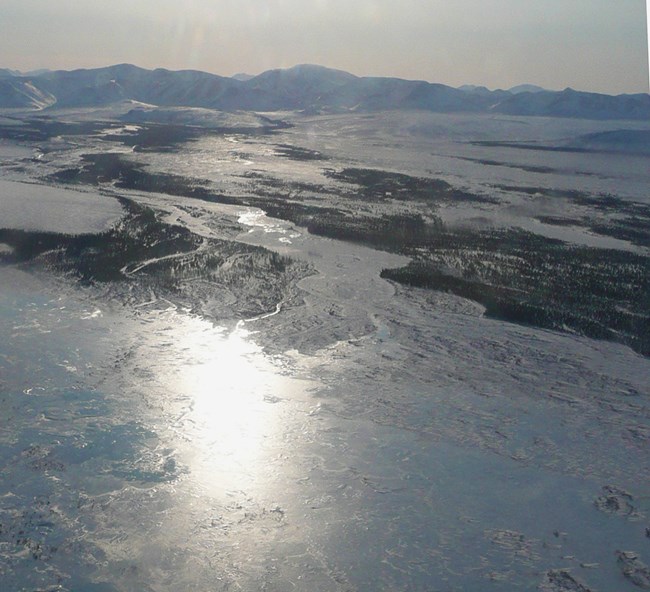Last updated: February 20, 2024
Article
Detecting Icing Events

NPS/Kyle Joly
Icing, also called rain-on-snow (ROS), events can dramatically impact vegetation and wildlife. Specifically for caribou, icing events can form hard crusts that make it difficult for them to access their primary winter food--lichens that grow close to the ground. Icing can also increase the amount of energy needed for wildlife to travel across it, for example, if caribou break through layers of ice crust. With the rapid warming of the Arctic, icing may become more frequent and widespread.
Long-term monitoring of icing events is still a developing science. An international team of researchers, including the National Park Service, found that using a combination of different satellite-based sensors effectively detected icing events across the Arctic and these promising tools could be used to fill in data gaps to help improve our monitoring and understanding of long-term trends in icing events in the region.
Towards long-term records of rain-on-snow events across the Arctic from satellite data
Abstract
Rain-on-snow (ROS) events occur across many regions of the terrestrial Arctic in mid-winter. Snowpack properties are changing, and in extreme cases ice layers form which affect wildlife, vegetation and soils beyond the duration of the event. Specifically, satellite microwave observations have been shown to provide insight into known events. Only Ku-band radar (scatterometer) has been applied so far across the entire Arctic. Data availability at this frequency is limited, however. The utility of other frequencies from passive and active systems needs to be explored to develop a concept for long-term monitoring. The latter are of specific interest as they can be potentially provided at higher spatial resolution. Radar records have been shown to capture the associated snow structure change based on time-series analyses. This approach is also applicable when data gaps exist and has capabilities to evaluate the impact severity of events. Active as well as passive microwave sensors can also detect wet snow at the timing of an ROS event if an acquisition is available. The wet snow retrieval methodology is, however, rather mature compared to the identification of snow structure change since ambiguous scattering behaviour needs consideration. C-band radar is of special interest due to good data availability including a range of nominal spatial resolutions (10 m–12.5 km). Scatterometer and SAR (synthetic aperture radar) data have therefore been investigated. The temperature dependence of C-band backscatter at VV (V – vertical) polarization observable down to −40 ∘C is identified as a major issue for ROS retrieval but can be addressed by a combination with a passive microwave wet snow indicator (demonstrated for Metop ASCAT – Advanced Scatterometer – and SMOS – Soil Moisture and Ocean Salinity). Results were compared to in situ observations (snowpit records, caribou migration data) and Ku-band products. Ice crusts were found in the snowpack after detected events (overall accuracy 82 %). The more crusts (events) there are, the higher the winter season backscatter increase at C-band will be. ROS events captured on the Yamal and Seward peninsulas have had severe impacts on reindeer and caribou, respectively, due to ice crust formation. SAR specifically from Sentinel-1 is promising regarding ice layer identification at better spatial details for all available polarizations. The fusion of multiple types of microwave satellite observations is suggested for the creation of a climate data record, but the consideration of performance differences due to spatial and temporal cover, as well as microwave frequency, is crucial. Retrieval is most robust in the tundra biome, where results are comparable between sensors. Records can be used to identify extremes and to apply the results for impact studies at regional scale.
Bartsch, A., H. Bergstedt, G. Pointner, X. Muri, K. Rautiainen, L. Leppänen, K. Joly, A. Sokolov, P. Orekhov, D. Ehrich, and E. M. Soininen. 2023. Towards long-term records of rain-on-snow events across the Arctic from satellite data. The Cryosphere 17(2): 889-915.
